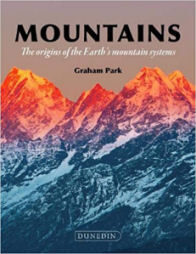By Graham Park

I have reviewed several of Graham Park’s books he has written for Dunedin in this website (Introducing Tectonics, Rock Structures and Introducing Natural Resources) and this is yet another fine example.
Mountains: The origins of the Earth’s mountain systems is written for readers with an interest in mountains and in developing their understanding of the geological processes that create them. To this end, it covers both currently active mountain systems in some detail, along with older mountain systems, including, for example, the Caledonian mountains in the UK, Scandinavia and Newfoundland. These may be categorised into three separate types of systems:
- The Alpine-Himalayan ranges and circum-Pacific belts.
- The mid-ocean ridges.
- The older, non-active mountain belts.
We now know that all are the direct result of plate tectonics and collisions of plates at current or former plate boundaries, and many are situated in relatively well-defined, narrow belts on active plate boundaries. This underlying plate-tectonic framework is covered in sufficient detail for the reader to understand the general process giving rise to mountains. However, Park also covers the now defunct, but still fascinating historical theories of orogenesis (and the geologists associated with them), such as ‘the contracting earth theory’ (Archibald Geikie and others) and those involving geosynclines (for example, Johannes Umbgrove).
The book covers all the major mountain ranges, but, for me, one of the most fascinating chapters is the one on the ocean ridges. The Mid-Atlantic Ridge is perhaps the most famous, being fundamental to our discovery and understanding of seafloor spreading, palaeomagnetism and plate tectonics. However, it is sobering to think that, if the world’s oceans were removed, a great system of mountain ridges would be revealed, larger even than the mighty Himalayas. These include the much less well-known Carlsberg-Central Indian Ridge, and the Southwest and Southeast Indian Ridges under the Indian Ocean. There are even several under the Pacific Ocean (for example, the East Pacific Rise).
The book also contains a glossary, references and a list of further reading, for those wanting to take their understanding further. The author is Emeritus Professor of Tectonic Geology at the University of Keele.
Mountains: the origins of the Earth’s mountain systems by Graham Park, Dunedin Academic Press, Edinburgh and London (2018), 212 pages (hardback), ISBN: 978-1780460666


